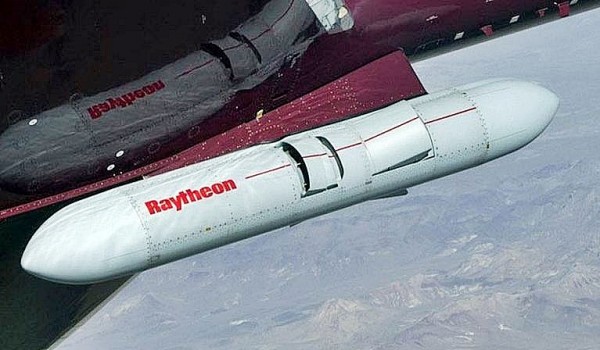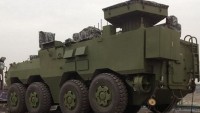US Navy Next Generation Jammer Threatens to Blind China’s A2/AD Network in South China Sea
| Arthur Dominic Villasanta | | Apr 22, 2017 08:28 AM EDT |
(Photo : Raytheon) Next Generation Jammer prototype from Raytheon.
The U.S. Navy in the future will turn to its airborne "Next Generation Jammer" (NGJ) to nullify the radar systems China has emplaced in defense of its illegal man-made islands in the South China Sea, and its anti-access, area-denial (A2/AD) network engulfing this territory.
NGJ is a digital electronic warfare (EW) "weapon" intended to counter new air-defense radars such as China's and Russia's digital radars. Being developed by Raytheon, it's an automated pod mounted onto the Boeing EA-18G Growler carrier-based electronic warfare aircraft deployed aboard U.S. Navy Nimitz-class aircraft carriers.
Like Us on Facebook
An EA-18 will carry two of the pods (each over three meters-long), one under each wing.
NGJ employs an Active Electronically Scanned Array (AESA) radar with gallium nitride components that amplify radio energy.
Airborne AESA radars are more difficult to detect by enemy EW systems because they can spread their signal emissions across a wider range of frequencies. This advantage complicates their detection over background noise and enables combat aircraft and warships to radiate powerful radar signals while remaining stealthy.
NGJ can generate 10 times the radiated isotropic power level of the existing AN/ALQ-99 airborne EW system. The signal is also "cleaner," minimizing the collateral interference with friendly signals.
NGJ can jam multiple frequencies. It's designed to be an "agile" jammer capable of analyzing new enemy signals and adjusting its own frequencies to counter them on the fly.
Since NGJ is a digital solid-state open-architecture system, it can be upgraded with new "threat libraries" of hostile hardware, allowing it to be easily upgraded to match new adversary capabilities.
NGJ can also spy on enemy communications. This means Growlers can serve as a potential Signals Intelligence (SIGINT) platforms.
All these advantages should be enough to counter China's air defense systems protecting its illegal holdings in the South China Sea.
The U.S. Department of Defense estimates China is placing huge emphasis on EWand will use this heightened capability to better defend its illegal holdings in the South China Sea against any attack by the United States.
China has also gone a step further than the U.S. by integrating electronic warfare and cyber warfare into a singular discipline that must be conducted simultaneously.
"The (People's Liberation Army) sees EW as an important force multiplier, and would likely employ it in support of all combat arms and services during a conflict," said the annual report on China's military and security developments submitted by the Pentagon.
TagsU.S. Navy, Next Generation Jammer, NGJ, Radar, Electronic Warfare, EW, china, South China Sea, Boeing EA-18G Growler, Active Electronically Scanned Array, AESA
©2015 Chinatopix All rights reserved. Do not reproduce without permission
EDITOR'S PICKS
-

Did the Trump administration just announce plans for a trade war with ‘hostile’ China and Russia?
-

US Senate passes Taiwan travel bill slammed by China
-

As Yan Sihong’s family grieves, here are other Chinese students who went missing abroad. Some have never been found
-

Beijing blasts Western critics who ‘smear China’ with the term sharp power
-

China Envoy Seeks to Defuse Tensions With U.S. as a Trade War Brews
-

Singapore's Deputy PM Provides Bitcoin Vote of Confidence Amid China's Blanket Bans
-

China warns investors over risks in overseas virtual currency trading
-

Chinese government most trustworthy: survey
-

Kashima Antlers On Course For Back-To-Back Titles
MOST POPULAR
LATEST NEWS
Zhou Yongkang: China's Former Security Chief Sentenced to Life in Prison

China's former Chief of the Ministry of Public Security, Zhou Yongkang, has been given a life sentence after he was found guilty of abusing his office, bribery and deliberately ... Full Article
TRENDING STORY

China Pork Prices Expected to Stabilize As The Supplies Recover

Elephone P9000 Smartphone is now on Sale on Amazon India

There's a Big Chance Cliffhangers Won't Still Be Resolved When Grey's Anatomy Season 13 Returns

Supreme Court Ruled on Samsung vs Apple Dispute for Patent Infringement

Microsoft Surface Pro 5 Rumors and Release Date: What is the Latest?













